Question 1
Refer to the topology shown in the exhibit. Which ports will be STP designated ports if all the links are operating at the same bandwidth? (Choose three)
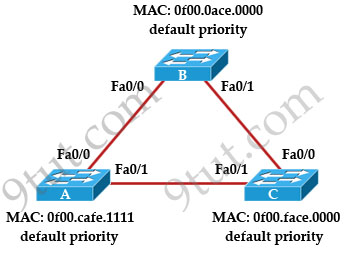
A. Switch A – Fa0/0
B. Switch A – Fa0/1
C. Switch B – Fa0/0
D. Switch B – Fa0/1
E. Switch C – Fa0/0
F. Switch C – Fa0/1
Answer: B C D
Explanation
First by comparing their MAC addresses we learn that switch B will be root bridge as it has lowest MAC. Therefore all of its ports are designated ports -> C & D are correct.
On the link between switch A & switch C there must have one designated port and one non-designated (blocked) port. We can figure out which port is designated port by comparing their MAC address again. A has lower MAC so Fa0/1 of switch A will be designated port while Fa0/1 of switch C will be blocked -> B is correct.
Question 2
What value is primarily used to determine which port becomes the root port on each non-root switch in a spanning-tree topology?
A. lowest port MAC address
B. port priority number and MAC address.
C. VTP revision number
D. highest port priority number.
E. path cost
Answer: E
Explanation
The path cost to the root bridge is the most important value to determine which port will become the root port on each non-root switch. In particular, the port with lowest cost to the root bridge will become root port (on non-root switch).
Question 3
What is one benefit of PVST+?
A. PVST+ reduces the CPU cycles for all the switches in the network.
B. PVST+ automatically selects the root bridge location, to provide optimization.
C. PVST+ allows the root switch location to be optimized per vlan.
D. PVST+ supports Layer 3 load balancing without loops.
Answer: C
Explanation
Per VLAN Spanning Tree (PVST) maintains a spanning tree instance for each VLAN configured in the network. It means a switch can be the root bridge of a VLAN while another switch can be the root bridge of other VLANs in a common topology. For example, Switch 1 can be the root bridge for Voice data while Switch 2 can be the root bridge for Video data. If designed correctly, it can optimize the network traffic.
Question 4
Which two protocols are used by bridges and/or switches to prevent loops in a layer 2 network? (Choose two)
A. 802.1d
B. VTP
C. 802.1q
D. STP
E. SAP
Answer: A D
Question 5
In which circumstance are multiple copies of the same unicast frame likely to be transmitted in a switched LAN?
A. after broken links are re-established
B. in an improperly implemented redundant topology
C. when upper-layer protocols require high reliability
D. during high traffic periods
E. when a dual ring topology is in use
Answer: B
Explanation
If we connect two switches via 2 or more links and do not enable STP on these switches then a loop (which creates multiple copies of the same unicast frame) will occur. It is an example of an improperly implemented redundant topology.
Question 6
Refer to the exhibit.
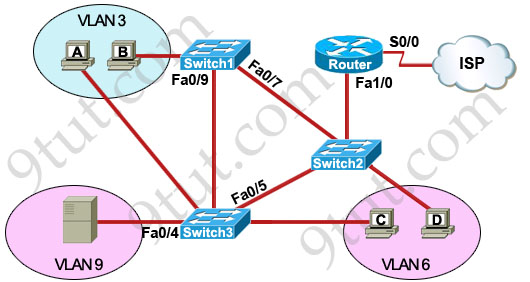
A problem with network connectivity has been observed. It is suspected that the cable connected to switch port Fa0/9 on Switch1 is disconnected. What would be an effect of this cable being disconnected?
A. Host B would not be able to access the server in VLAN9 until the cable is reconnected.
B. Communication between VLAN3 and the other VLANs would be disabled.
C. The transfer of files from Host B to the server in VLAN9 would be significantly slower.
D. For less than a minute, Host B would not be able to access the server in VLAN9. Then normal network function would resume.
Answer: D
Question 7
Which port state is introduced by Rapid-PVST?
A. learning
B. listening
C. discarding
D. forwarding
Answer: C
Explanation
PVST+ is based on IEEE802.1D Spanning Tree Protocol (STP). But PVST+ has only 3 port states (discarding, learning and forwarding) while STP has 5 port states (blocking, listening, learning, forwarding and disabled). So discarding is a new port state in PVST+.
Question 8
Refer to the exhibit. Based on the information given, which switch will be elected root bridge and why?
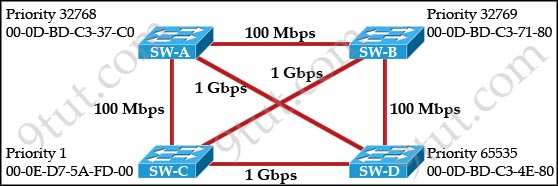
A. Switch A, because it has the lowest MAC address
B. Switch A, because it is the most centrally located switch
C. Switch B, because it has the highest MAC address
D. Switch C, because it is the most centrally located switch
E. Switch C, because it has the lowest priority
F. Switch D, because it has the highest priority
Answer: E
Question 9
Which term describes a spanning-tree network that has all switch ports in either the blocking or forwarding state?
A. redundant
B. spanned
C. provisioned
D. converged
Answer: D
Explanation
Spanning Tree Protocol convergence (Layer 2 convergence) happens when bridges and switches have transitioned to either the forwarding or blocking state. When layer 2 is converged, root bridge is elected and all port roles (Root, Designated and Non-Designated) in all switches are selected.
Question 10
Refer to the exhibit. Given the output shown from this Cisco Catalyst 2950, what is the most likely reason that interface FastEthernet 0/10 is not the root port for VLAN 2?
Switch# show spanning-tree interface fastethernet0/10

A. This switch has more than one interface connected to the root network segment in VLAN 2.
B. This switch is running RSTP while the elected designated switch is running 802.1d Spanning Tree.
C. This switch interface has a higher path cost to the root bridge than another in the topology.
D. This switch has a lower bridge ID for VLAN 2 than the elected designated switch.
Answer: C
Question 11
Three switches are connected to one another via trunk ports. Assuming the default switch configuration, which switch is elected as the root bridge for the spanning-tree instance of VLAN 1?
A. the switch with the highest MAC address
B. the switch with the lowest MAC address
C. the switch with the highest IP address
D. the switch with the lowest IP address
Answer: B
Question 12
Based on the network shown in the graphic
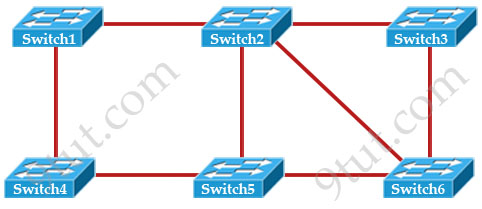
Which option contains both the potential networking problem and the protocol or setting that should be used to prevent the problem?
A. routing loops, hold down timers
B. Switching loops, split horizon
C. routing loops, split horizon
D. Switching loops, VTP
E. routing loops, STP
F. Switching loops, STP
Answer: F
Question 13
Refer to the exhibit. Which switch provides the spanning-tree designated port role for the network segment that services the printers?
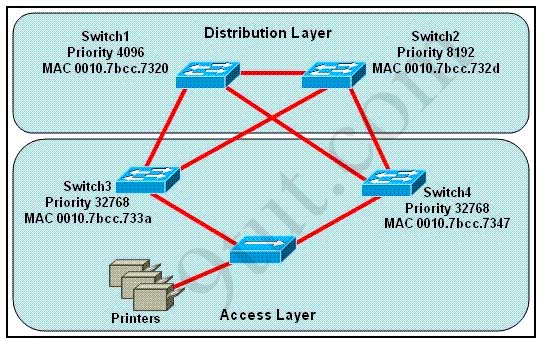
A. Switch1
B. Switch2
C. Switch3
D. Switch4
Answer: C
Explanation
First, the question asks what switch services the printers, so it can be Switch 3 or Switch 4 which is connected directly to the Printers.
Next, by comparing the MAC address of Switch 3 and Switch 4 we found that the MAC of Switch 3 is smaller. Therefore the interface connected to the Printers of Switch 3 will become designated interface and the interface of Switch 4 will be blocked. The picture below shows the roles of all ports:
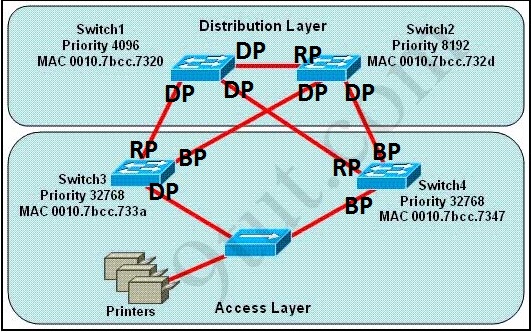
DP: Designated Port
RP: Root Port
BP: Blocked Port
(Please notice that Switch 1 will become the root bridge because of its lowest priority, not Switch 3)
Refer to the topology shown in the exhibit. Which ports will be STP designated ports if all the links are operating at the same bandwidth? (Choose three)

A. Switch A – Fa0/0
B. Switch A – Fa0/1
C. Switch B – Fa0/0
D. Switch B – Fa0/1
E. Switch C – Fa0/0
F. Switch C – Fa0/1
Answer: B C D
Explanation
First by comparing their MAC addresses we learn that switch B will be root bridge as it has lowest MAC. Therefore all of its ports are designated ports -> C & D are correct.
On the link between switch A & switch C there must have one designated port and one non-designated (blocked) port. We can figure out which port is designated port by comparing their MAC address again. A has lower MAC so Fa0/1 of switch A will be designated port while Fa0/1 of switch C will be blocked -> B is correct.
Question 2
What value is primarily used to determine which port becomes the root port on each non-root switch in a spanning-tree topology?
A. lowest port MAC address
B. port priority number and MAC address.
C. VTP revision number
D. highest port priority number.
E. path cost
Answer: E
Explanation
The path cost to the root bridge is the most important value to determine which port will become the root port on each non-root switch. In particular, the port with lowest cost to the root bridge will become root port (on non-root switch).
Question 3
What is one benefit of PVST+?
A. PVST+ reduces the CPU cycles for all the switches in the network.
B. PVST+ automatically selects the root bridge location, to provide optimization.
C. PVST+ allows the root switch location to be optimized per vlan.
D. PVST+ supports Layer 3 load balancing without loops.
Answer: C
Explanation
Per VLAN Spanning Tree (PVST) maintains a spanning tree instance for each VLAN configured in the network. It means a switch can be the root bridge of a VLAN while another switch can be the root bridge of other VLANs in a common topology. For example, Switch 1 can be the root bridge for Voice data while Switch 2 can be the root bridge for Video data. If designed correctly, it can optimize the network traffic.
Question 4
Which two protocols are used by bridges and/or switches to prevent loops in a layer 2 network? (Choose two)
A. 802.1d
B. VTP
C. 802.1q
D. STP
E. SAP
Answer: A D
Question 5
In which circumstance are multiple copies of the same unicast frame likely to be transmitted in a switched LAN?
A. after broken links are re-established
B. in an improperly implemented redundant topology
C. when upper-layer protocols require high reliability
D. during high traffic periods
E. when a dual ring topology is in use
Answer: B
Explanation
If we connect two switches via 2 or more links and do not enable STP on these switches then a loop (which creates multiple copies of the same unicast frame) will occur. It is an example of an improperly implemented redundant topology.
Question 6
Refer to the exhibit.

A problem with network connectivity has been observed. It is suspected that the cable connected to switch port Fa0/9 on Switch1 is disconnected. What would be an effect of this cable being disconnected?
A. Host B would not be able to access the server in VLAN9 until the cable is reconnected.
B. Communication between VLAN3 and the other VLANs would be disabled.
C. The transfer of files from Host B to the server in VLAN9 would be significantly slower.
D. For less than a minute, Host B would not be able to access the server in VLAN9. Then normal network function would resume.
Answer: D
Question 7
Which port state is introduced by Rapid-PVST?
A. learning
B. listening
C. discarding
D. forwarding
Answer: C
Explanation
PVST+ is based on IEEE802.1D Spanning Tree Protocol (STP). But PVST+ has only 3 port states (discarding, learning and forwarding) while STP has 5 port states (blocking, listening, learning, forwarding and disabled). So discarding is a new port state in PVST+.
Question 8
Refer to the exhibit. Based on the information given, which switch will be elected root bridge and why?

A. Switch A, because it has the lowest MAC address
B. Switch A, because it is the most centrally located switch
C. Switch B, because it has the highest MAC address
D. Switch C, because it is the most centrally located switch
E. Switch C, because it has the lowest priority
F. Switch D, because it has the highest priority
Answer: E
Question 9
Which term describes a spanning-tree network that has all switch ports in either the blocking or forwarding state?
A. redundant
B. spanned
C. provisioned
D. converged
Answer: D
Explanation
Spanning Tree Protocol convergence (Layer 2 convergence) happens when bridges and switches have transitioned to either the forwarding or blocking state. When layer 2 is converged, root bridge is elected and all port roles (Root, Designated and Non-Designated) in all switches are selected.
Question 10
Refer to the exhibit. Given the output shown from this Cisco Catalyst 2950, what is the most likely reason that interface FastEthernet 0/10 is not the root port for VLAN 2?
Switch# show spanning-tree interface fastethernet0/10

A. This switch has more than one interface connected to the root network segment in VLAN 2.
B. This switch is running RSTP while the elected designated switch is running 802.1d Spanning Tree.
C. This switch interface has a higher path cost to the root bridge than another in the topology.
D. This switch has a lower bridge ID for VLAN 2 than the elected designated switch.
Answer: C
Question 11
Three switches are connected to one another via trunk ports. Assuming the default switch configuration, which switch is elected as the root bridge for the spanning-tree instance of VLAN 1?
A. the switch with the highest MAC address
B. the switch with the lowest MAC address
C. the switch with the highest IP address
D. the switch with the lowest IP address
Answer: B
Question 12
Based on the network shown in the graphic

Which option contains both the potential networking problem and the protocol or setting that should be used to prevent the problem?
A. routing loops, hold down timers
B. Switching loops, split horizon
C. routing loops, split horizon
D. Switching loops, VTP
E. routing loops, STP
F. Switching loops, STP
Answer: F
Question 13
Refer to the exhibit. Which switch provides the spanning-tree designated port role for the network segment that services the printers?

A. Switch1
B. Switch2
C. Switch3
D. Switch4
Answer: C
Explanation
First, the question asks what switch services the printers, so it can be Switch 3 or Switch 4 which is connected directly to the Printers.
Next, by comparing the MAC address of Switch 3 and Switch 4 we found that the MAC of Switch 3 is smaller. Therefore the interface connected to the Printers of Switch 3 will become designated interface and the interface of Switch 4 will be blocked. The picture below shows the roles of all ports:

DP: Designated Port
RP: Root Port
BP: Blocked Port
(Please notice that Switch 1 will become the root bridge because of its lowest priority, not Switch 3)